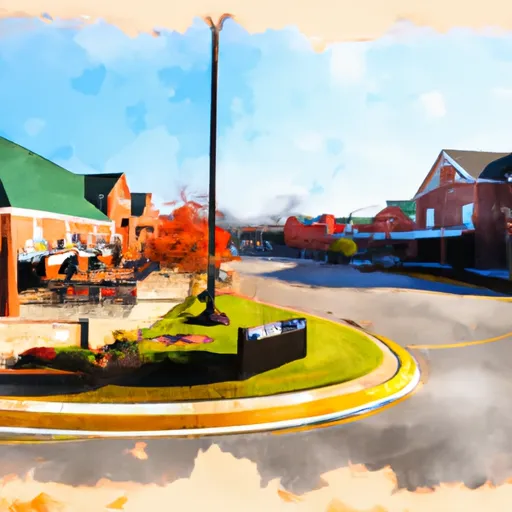-
 Snoflo Premium
Snoflo Premium
Get unlimited access to all our content
With no Ad interruptions! - Start Your Free Trial Login with existing account
Milton
Eden Index
Climate
7.6
•
Recreation
2.0
•
Community
•
Safeguard
3.7/10

Located in Rutherford County, Tennessee, Milton is a small town with a quaint charm. The climate in Milton is characterized by hot and humid summers, with temperatures often reaching the mid-90s Fahrenheit, and mild winters with occasional snowfall. The area receives an average annual rainfall of around 50 inches.
Milton is situated near the Stones River, which provides a vital source of water and hydrology constituents for the town. The river offers opportunities for fishing, boating, and canoeing, attracting outdoor enthusiasts. The diverse aquatic ecosystem supports a variety of fish species, including bass, crappie, and catfish.
In addition to the river, Milton boasts several outdoor recreation opportunities. Nearby parks and natural areas provide hiking and biking trails, picnic areas, and camping sites. For nature lovers, exploring these scenic landscapes is a must, offering a chance to observe wildlife and enjoy the serenity of the surroundings.
Overall, Milton, Tennessee, with its favorable climate, access to the Stones River, and various outdoor recreation opportunities, provides an ideal setting for individuals seeking to connect with nature and engage in outdoor activities.
What is the Eden Index?
The Snoflo Eden Index serves as a comprehensive rating system for regions, evaluating their desirability through a holistic assessment of climate health, outdoor recreation opportunities, and natural disaster risk, acknowledging the profound impact of these factors on livability and well-being.
Climate Health Indicator (CHI): 7.6
Milton receives approximately
1403mm of rain per year,
with humidity levels near 84%
and air temperatures averaging around
15°C.
Milton has a plant hardyness factor of
7, meaning
plants and agriculture in this region tend to thrive during the non-winter months.
By considering the ideal temperature range, reliable water supplies, clean air, and stable seasonal rain or snowpacks, the Climate Health Indicator (CHI) underscores the significance of a healthy climate as the foundation for quality living.
A healthy climate is paramount for ensuring a high quality of life and livability in a region, fostering both physical well-being and environmental harmony. This can be characterized by ideal temperatures, reliable access to water supplies, clean air, and consistent seasonal rain or snowpacks.
Weather Forecast
Streamflow Conditions
Lower Cumberland
Area Rivers
Lower Cumberland
Snowpack Depths
Lower Cumberland
Reservoir Storage Capacity
Lower Cumberland
Groundwater Levels
Recreational Opportunity Index (ROI): 2.0
The Recreational Opportunity Index (ROI) recognizes the value of outdoor recreational options, such as parks, hiking trails, camping sites, and fishing spots, while acknowledging that climate plays a pivotal role in ensuring the comfort and consistency of these experiences.
Access to outdoor recreational opportunities, encompassing activities such as parks, hiking, camping, and fishing, is crucial for overall well-being, and the climate plays a pivotal role in enabling and enhancing these experiences, ensuring that individuals can engage in nature-based activities comfortably and consistently.
Camping Areas
| Campground | Campsites | Reservations | Toilets | Showers | Elevation |
|---|---|---|---|---|---|
| Arnold AFB Military | None | 1,001 ft | |||
| Lake Guntersville State Park | 366 | 630 ft | |||
| Bucks Pocket State Park | 36 | 890 ft | |||
| Goose Pond Colony | None | 618 ft | |||
| Jackson County Park | None | 627 ft | |||
| Barton Springs - Normandy Lake | 67 | 885 ft | |||
| Cathedral Caverns State Park | None | 643 ft | |||
| Noccalula Falls Campground | None | 732 ft | |||
| Marshall County Park | None | 598 ft | |||
| Tims Ford State Park | 52 | 936 ft |
Nearby Ski Areas
Catastrophe Safeguard Index (CSI):
The Catastrophe Safeguard Index (CSI) recognizes that natural disaster risk, encompassing floods, fires, hurricanes, and tornadoes, can drastically affect safety and the overall appeal of an area.
The level of natural disaster risk in a region significantly affects safety and the overall livability, with climate change amplifying these risks by potentially increasing the frequency and intensity of events like floods, fires, hurricanes, and tornadoes, thereby posing substantial challenges to community resilience and well-being.
Community Resilience Indicator (CRI):
The Community Resilience Indicator (CRI) recognizes that education, healthcare, and socioeconomics are crucial to the well-being of a region. The CRI acknowledges the profound impact of these elements on residents' overall quality of life. By evaluating educational resources, healthcare accessibility, and economic inclusivity, the index captures the essential aspects that contribute to a thriving community, fostering resident satisfaction, equity, and social cohesion.

